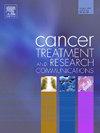Relationship between p53 protein and ER, PR status in breast cancer tissue
Q3 Medicine
引用次数: 0
Abstract
The aim of the present study was to investigate the protein expression levels of p53 in breast cancer tissues and analyze the relationship between the increased protein expression levels of p53 and the status of the estrogen receptor (ER) and progesterone receptor (PR). A total of 137 patients with breast cancer admitted to the General Surgery Department of the People's Liberation Army General Hospital from June to October 2023 were selected for inclusion in the present study and the expression levels of p53, ER and PR in cancer tissues were detected using immunohistochemistry. According to postoperative pathological results, patients were divided into ER positive negative groups and PR positive negative groups. Chi-squared tests used to analyze the difference in the protein expression levels of p53 between the ER positive and negative groups and the PR positive and negative groups. Additionally, the relationship between the protein expression levels of p53 in breast cancer tissue with patient age, the longest tumor diameter, tumor TNM stage, axillary lymph node status and histological subtype were analyzed. The protein expression levels of p53 in the ER positive and negative groups was 38.27 and 66.07 %, respectively, and the difference was statistically significant.The protein expression levels of p53 in the PR positive and negative groups was 42.27 and 67.50 %, respectively, and the difference was statistically significant. The protein expression levels of p53 in breast cancer tissue was not significantly associated with patient age, the longest tumor diameter, tumor TNM stage and histological subtype. But it was related to the status of axillary lymph nodes, the difference was statistically significant. In conclusion, the protein expression levels of p53 in breast cancer tissues were negatively correlated with the expression of ER and PR, which could be used to potentially provide clinical guidance for the prognosis of patients with breast cancer and improve the diagnosis and treatment of these patients in the future.
乳腺癌组织中p53蛋白与ER、PR水平的关系
本研究旨在探讨p53在乳腺癌组织中的蛋白表达水平,分析p53蛋白表达水平升高与雌激素受体(ER)和孕激素受体(PR)状态的关系。选择2023年6月至10月解放军总医院普外科收治的乳腺癌患者137例,采用免疫组化方法检测肿瘤组织中p53、ER、PR的表达水平。根据术后病理结果将患者分为ER阳性阴性组和PR阳性阴性组。卡方检验用于分析ER阳性和阴性组以及PR阳性和阴性组之间p53蛋白表达水平的差异。分析乳腺癌组织中p53蛋白表达水平与患者年龄、肿瘤最长直径、肿瘤TNM分期、腋窝淋巴结状态及组织学亚型的关系。ER阳性组和阴性组p53蛋白表达量分别为38.27%和66.07%,差异有统计学意义。PR阳性组和阴性组p53蛋白表达量分别为42.27%和67.50%,差异有统计学意义。乳腺癌组织中p53蛋白表达水平与患者年龄、肿瘤最长直径、肿瘤TNM分期及组织学亚型无显著相关性。但与腋窝淋巴结状况有关,差异有统计学意义。综上所述,乳腺癌组织中p53蛋白表达水平与ER、PR表达呈负相关,可为乳腺癌患者的预后提供临床指导,提高乳腺癌患者的诊治水平。
本文章由计算机程序翻译,如有差异,请以英文原文为准。
求助全文
约1分钟内获得全文
求助全文
来源期刊

Cancer treatment and research communications
Medicine-Oncology
CiteScore
4.30
自引率
0.00%
发文量
148
审稿时长
56 days
期刊介绍:
Cancer Treatment and Research Communications is an international peer-reviewed publication dedicated to providing comprehensive basic, translational, and clinical oncology research. The journal is devoted to articles on detection, diagnosis, prevention, policy, and treatment of cancer and provides a global forum for the nurturing and development of future generations of oncology scientists. Cancer Treatment and Research Communications publishes comprehensive reviews and original studies describing various aspects of basic through clinical research of all tumor types. The journal also accepts clinical studies in oncology, with an emphasis on prospective early phase clinical trials. Specific areas of interest include basic, translational, and clinical research and mechanistic approaches; cancer biology; molecular carcinogenesis; genetics and genomics; stem cell and developmental biology; immunology; molecular and cellular oncology; systems biology; drug sensitivity and resistance; gene and antisense therapy; pathology, markers, and prognostic indicators; chemoprevention strategies; multimodality therapy; cancer policy; and integration of various approaches. Our mission is to be the premier source of relevant information through promoting excellence in research and facilitating the timely translation of that science to health care and clinical practice.
 求助内容:
求助内容: 应助结果提醒方式:
应助结果提醒方式:


